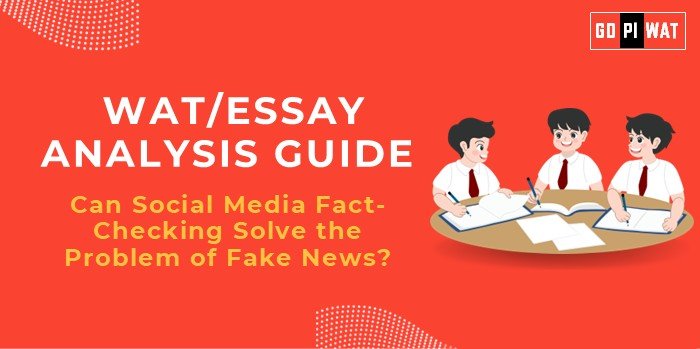📋 Written Ability Test (WAT) Analysis Guide
🗨️ Can Social Media Fact-Checking Solve the Problem of Fake News?
🌟 Understanding the Topic’s Importance
Fake news poses a significant threat to societal trust, influencing vital areas like politics, public health, and global security. In an era where misinformation spreads faster than facts, social media’s role in mitigating this issue is critical. For B-school candidates, this topic reflects core challenges in ethics, communication strategies, and technology-driven leadership, emphasizing the need for informed decision-making in complex environments.
⏱️ Effective Planning and Writing
- Time Allocation:
- Planning: 5 minutes
- Writing: 20 minutes
- Review: 5 minutes
- Preparation Tips:
- Identify and note 2-3 compelling statistics (e.g., percentage of users encountering fake news, success rates of fact-checking initiatives).
- Frame arguments with concrete examples, such as misinformation during elections, public health crises like COVID-19, or the adoption of AI tools for fact-checking.
- Brainstorm potential solutions beyond fact-checking to create a well-rounded perspective.
💡 Introduction Techniques
- Contrast Approach: “While fact-checking mechanisms have successfully reduced the spread of misinformation by 20%, over 59% of global users still encounter fake news weekly, underscoring the complexity of addressing this pervasive issue.”
- Solution-Oriented Approach: “In the digital age, fake news threatens to erode public trust and societal stability. By enhancing fact-checking tools, fostering media literacy, and leveraging technology, social media platforms can mitigate its impact significantly.”
🛠️ Structuring the Essay Body
✅ Achievements
Discuss success stories of social media fact-checking initiatives:
- Twitter’s labels during the U.S. elections, which reduced retweets of flagged misinformation by 25%.
- India’s WhatsApp pilot project during the 2024 elections, which resolved over 5,000 fake news queries.
⚠️ Challenges with Comparative Analysis
Highlight ongoing issues using global examples:
- Scalability Issues: Addressing local misinformation across diverse languages and cultures, as seen in India.
- Bias Concerns: Instances in the U.S. where fact-checking efforts were criticized for political favoritism.
- Censorship Risks: Efforts that inadvertently suppress legitimate discourse.
🔮 Future Outlook
Propose forward-looking solutions:
- AI and Machine Learning: Tools like Google Fact Check Explorer for scalable and automated verification.
- Global Cooperation: Adopting standards inspired by Estonia’s AI-driven election monitoring or Singapore’s digital governance framework.
- Education Initiatives: Media literacy programs to empower users to discern misinformation independently.
🤝 Concluding Effectively
- Balanced Perspective: “Fact-checking is an essential tool in combating fake news but remains insufficient as a standalone solution. To address this issue comprehensively, platforms must integrate advanced technologies and invest in user education.”
- Global Comparison: “While nations like Estonia showcase the potential of AI-driven fact-checking, a unified global framework that emphasizes transparency, scalability, and inclusivity is crucial for long-term success.”
📄 Sample Essays
⚖️ Balanced Perspective
“Fact-checking plays a vital role in reducing the spread of fake news, but its limitations, such as scalability and accusations of bias, indicate the need for a multi-faceted approach. Incorporating AI, fostering transparency, and educating users on media literacy are critical steps toward mitigating the pervasive threat of misinformation.”
🔧 Solution-Oriented
“Social media platforms must prioritize fact-checking enhancements, leveraging AI and collaborating with governments to address fake news effectively. However, these efforts should be complemented by initiatives that promote digital literacy and establish transparent frameworks to ensure their credibility.”
🌍 Global Comparison
“Countries like Estonia demonstrate the power of AI in mitigating misinformation during elections. By adopting similar practices, global social media platforms can strengthen their fact-checking systems and collaborate internationally to combat fake news comprehensively.”


